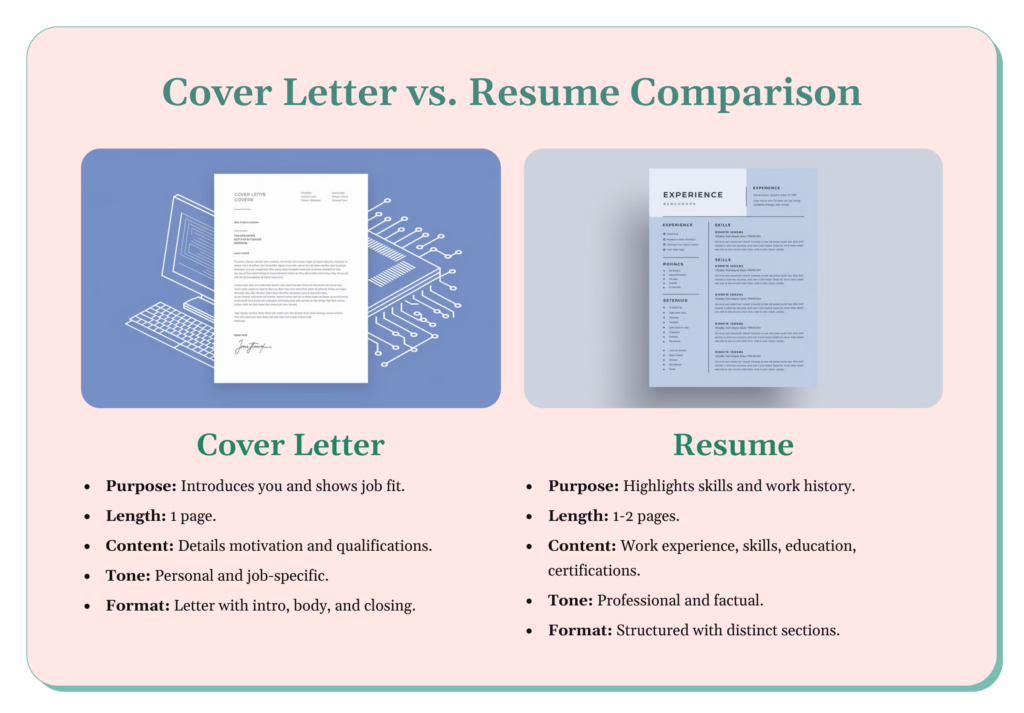
Quick Summary
Table of Contents
When applying for jobs, two essential documents come into play: a cover letter and resume. While both serve the purpose of showcasing your qualifications, they differ in content, tone, and structure. Many job seekers wonder, “Do I need both?” or “What is the difference between cover letter and resume?”
Understanding the cover letter and resume distinction is crucial for crafting a strong application. The resume contains information about your experience, categorized in a summary form. On the other hand, the cover letter tells the story of the job application, your interest in the position, and why you would be suitable for it.
A resume is, in fact, a factual representation of one’s skills, education, and work experience, usually presented in bullet points. On the other hand, a cover letter is a personal letter of introduction in which you can go into more depth about your motivation and fit for the position.

The cover letter vs resume debate is one of the most talked-about topics in job seekers’ forums. Both your resume and cover letter are essential components of your job application, with the resume showcasing your qualifications and the cover letter highlighting your motivation and fit for the role. A resume supplies the candidate’s qualifications, work history, and skills. Still, the cover letter better personalizes the introduction of the candidate and how or why the candidate is perfect for the role.
A job cover letter is an individual pitch to a specific hiring manager. A good cover letter supplements your resume with a personal narrative and expresses your interest in the position. While a resume acts as a dry qualification of your application, cover letters allow you to include your personality in your expression of interest in that role.
A well-written cover letter serves multiple purposes:
An engaging cover letter for freshers attached to an application shows the person behind the application. It explains something of your passion and fit for the role of a hiring manager beyond your qualifications. Therefore, a well-written cover letter can boost your chances of an interview by making a powerful first impression.
While a resume and cover letter are essential in a job application, they serve distinct purposes that complement each other.
Knowing the difference between a cover letter and a resume is fundamental in creating a well-rounded job application. The key difference in a cover letter vs resume is that the cover letter adds a personal touch to your application, while the resume focuses on your skills and work history. Proper alignment of the two documents will allow you to be distinguished and invited for an interview.
| Aspect | Resume | Cover Letter |
| Content | Lists job experience, education, skills, and certifications (in bullet points). | A tailored introduction, explanation of relevant experiences, and a closing statement (in paragraphs). |
| Purpose | Summarizes qualifications and work history to showcase skills and experience. | Provides a personalized narrative to explain why you’re applying for the job and why you’re the right fit. |
| Formatting | Structured with headings, sections, and bullet points. Typically 1-2 pages long. | One-page narrative with an introduction, body, and conclusion. |
| Tone | Formal and concise, focusing on facts and avoiding unnecessary words. | Conversational, highlighting enthusiasm and personality. |
| Length | Typically 1-2 pages, with bullet points for easy scanning. | One page, written in full sentences and paragraphs. |
| Style | Focused on brevity and factual presentation. | More expressive, using first-person language to build a connection. |
This table highlights the core distinctions between a resume and cover letter. While the resume is structured for easy scanning, the cover letter lets you connect with hiring managers on a more personal level, helping you stand out in a competitive job market.
Some job applications require a letter of application specifically. This typically happens in places where communication skill or leadership prowess is an essential requirement to the job posting. For example, marketing or public relations-related jobs, managers, or other writing positions entail a cover letter to determine qualification and the skill to communicate oneself toward the employer.
When applying for such roles, a well-crafted cover letter can strengthen your application by:
Even if not explicitly required, submitting a cover letter for job applications can set you apart from other candidates, especially in competitive fields.
In some cases, submitting a resume alone may be sufficient, particularly when:
Your resume will speak for itself in these cases, showcasing your qualifications and experience. However, including a cover letter when optional can still enhance your application, primarily if you can provide a strong reason for your interest in the company.
A strong resume is critical in this highly competitive job world. Strong and straightforward are keywords that should define the nature of your resume. Organize it well and customize it for every job application. Here are the things that must be included.
A cover letter lets you add a personal touch and explain why you’re an excellent fit for the role. Here’s how to structure your letter effectively:
These best practices will make your resume and cover letter tailored, professional, and compelling.

A poorly constructed resume can harm your chances of landing an interview. Here are common mistakes to avoid:
While a cover letter is your opportunity to showcase your personality, avoid these common pitfalls:
Avoiding these mistakes can significantly affect the effectiveness of your resume and cover letter.
Led a team of 5 marketers, increasing brand engagement by 40%.
Managed digital ad campaigns, generating $200K+ in revenue.
I am excited to apply for the Marketing Manager position at [Company Name]. With 5+ years of experience in digital marketing, I have successfully led campaigns that boosted engagement by 40% and increased revenue by $200K.
At ABC Company, I managed a team of marketers, driving innovative strategies that improved brand awareness. I thrive in data-driven environments where I can apply my SEO, content strategy, and digital advertising expertise.
I am eager to bring my analytical mindset and leadership skills to [Company Name]. I welcome the opportunity to discuss how my background aligns with your company’s goals. Please get in touch with me at [Phone Number] or [Email] to arrange a conversation.
Sincerely,
John Doe
The resume and cover letter are essential parts of your job application process. While the resume is a structured summary of your qualifications, work experience, and skills, the cover letter gives it a personal touch. The resume is factual, allowing employers to assess your qualifications quickly. In contrast, the cover letter lets you express enthusiasm for the role and explain why you’re the perfect fit for the company.
A personal touch. The resume is factual, allowing employers to assess your qualifications quickly. In contrast, the cover letter lets you express enthusiasm for the role and explain why you’re the perfect fit for the company.
A resume and a well-crafted cover letter create a comprehensive application. The resume provides scope for the work experiences, and the cover letter gives focus and personality. They paint a description of your qualifications, passion, and commitment, which much increases your chances of getting an interview and eventually winning the job. When preparing for a job application, knowing how to balance a cover letter vs resume ensures you highlight both your professional qualifications and personal motivations effectively. So always use both of these documents to leave a good impression!
No, a resume and cover letter serve different purposes. A resume is a structured summary of skills, experience, and qualifications, while a cover letter is a personalized document explaining why you’re a good fit for the job. Using a resume as a cover letter would lack the persuasive, tailored approach recruiters expect.
A CV is not the same as a resume and cover letter combined. While a CV is a comprehensive document listing detailed academic and professional achievements, a cover letter is a personalized introduction. A resume is typically a concise, skills-focused version of a CV, primarily used for job applications.
No, a cover letter for a job cannot replace a resume. A cover letter introduces you to employers, explaining your motivation and qualifications, but a resume provides structured details on your work experience and skills. Both documents complement each other and are often required together in job applications.
No, a CV and a resume are different. A CV is more detailed, covering academic history, research, and publications, making it ideal for academia or research roles. A resume, in contrast, is a concise summary of skills and experience tailored to a specific job. A resume and cover letter together strengthen job applications.
Cover letter vs resume: A cover letter and resume serve different purposes; one isn’t necessarily better. A resume highlights one’s qualifications and experience in a structured format. A cover letter for a job allows candidates to express interest in a position and explain, in their view, why their background and abilities suit them. Both are essential for a strong application.

Authored by, Amay Mathur | Senior Editor




Amay Mathur is a business news reporter at Chegg.com. He previously worked for PCMag, Business Insider, The Messenger, and ZDNET as a reporter and copyeditor. His areas of coverage encompass tech, business, strategy, finance, and even space. He is a Columbia University graduate.
Editor's Recommendations
Chegg India does not ask for money to offer any opportunity with the company. We request you to be vigilant before sharing your personal and financial information with any third party. Beware of fraudulent activities claiming affiliation with our company and promising monetary rewards or benefits. Chegg India shall not be responsible for any losses resulting from such activities.
Chegg India does not ask for money to offer any opportunity with the company. We request you to be vigilant before sharing your personal and financial information with any third party. Beware of fraudulent activities claiming affiliation with our company and promising monetary rewards or benefits. Chegg India shall not be responsible for any losses resulting from such activities.